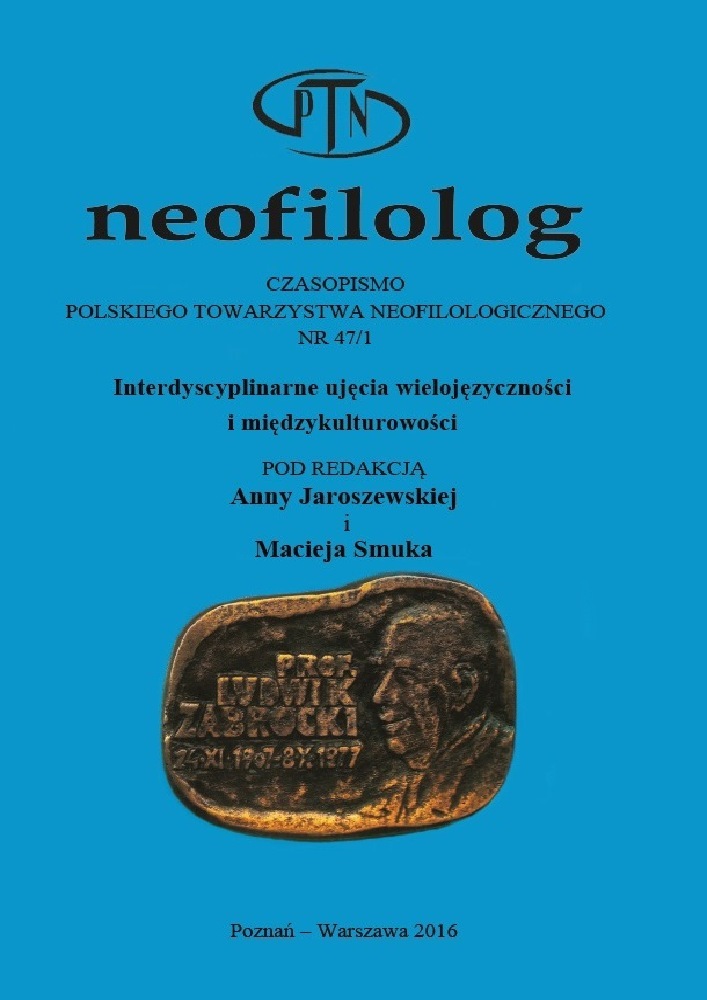Abstract
The purpose of this article is to show different approaches and trends in foreign language teaching in Polish schools over the last two decades. Emphasis will be placed on changing the skills and competencies needed to succeed to transition from the bilingual to the multilingual
citizen. European population is becoming more and more multicultural, with a growing diversity of cultures, races, values, and languages. The article also presents some examples of research with regard to attitudes and stereotypes. It is observable that this phenomenon exerts impact on the effective classroom management. Taking into account the new context of work in foreign language classrooms, the author focuses on strategies and key challenges encountered by teachers such as: differences in motivation or interests, individualization resulting from the biography of a language, cultural baggage, linguistic interference, and implementation of new technologies.
Literaturhinweise
Addisu, V. M. 2014. „Langues et identités en contexte exolingue: discours de trois couples franco-éthiopiens à Addis-Abeba”, Langage et Société, 147: 83-96.
Arnold, A. i M. Candea. 2015. „Comment étudier l’influence des stéréotypes de genre et de racesur la perception de la parole ?”, Langage et Société, 152: 75-96.
Calvet, L-J. 1999. Pour une écologie des langues du monde. Paris: Plon.
Dubois, L. i M. LeBlanc. 2014. „La traduction au Nouveau-Brunswick: contacts des langues et complexités sociolinguistiques”, Langage et Société, 147: 113-132.
Joshi, M. 2014. „Familles mixtes et usages des langues: une étude des politiques linguistiquesfamiliales dans le contexte indien”, Langage et Société, 147: 35-49.
Komorowska, H., 2013. „Multilingualism: Its open and hidden agendas”. Studies in Second Language Learning and Teaching 3(4): 463-482.
Lacroix, I. 2014. „Valeur symbolique de la langue au Pays basque français et choix de l'écolepour les enfants de couples linguistiquement mixtes”, Langage et Société, 147: 67-82.
Niedzielski, N. 1999. „The effect of social information on the perception of sociolinguistic variables”, Journal of Social Psychology (Special Edition), 18(1): 62-85.
Rubin, D. L. 1992. „Nonlanguage Factors Affecting Undergraduates' Judgments of Nonnative English-Speaking Teaching Assistants”, Research in Higher Education 33(4): 511-531.
Warschauer, M. i C. Meskill. 2000: „Technology and second language learning”. (w) Handbook of undergraduate second language education (red. J. Rosenthal). Mahwah, New Jersey: Lawrence Erlbaum, str. 303-318.
Widła, H. 2007. „L'acquisition du français – langue troisième: problèmes méthodologiques et implications pratiques”. Katowice: Wydawnictwo Uniwersytetu Śląskiego.
Young A. i L. Mary. 2009. „Former les professeurs stagiaires à la diversité linguistique à l'école”, Le Français Aujourd'hui, 164: 87-97.
Eurobaromètre spécial 2005: Les européens et leurs langues [online: http://ec.europa.eu/public_opinion/archives/ebs/ebs_243_fr.pdf; DW 14.12.2014].
Special Eurobarometer 2012: Europeans and their languages [online: http://ec.europa.eu/public_opinion/archives/ebs/ebs_386_en.pdf; DW 12.01.2015].
Lizenz
Copyright (c) 2016 Halina Widła

Dieses Werk steht unter der Lizenz Creative Commons Namensnennung - Keine Bearbeitungen 4.0 International.
Autoren:
Die Autoren der zur Veröffentlichung in der Zeitschrift Neofilolog angenommenen Texte sind verpflichtet, den Vertrag über die Erteilung einer kostenlosen Lizenz für die Werke mit der Verpflichtung zur Erteilung einer Sublizenz CC auszufüllen, zu unterzeichnen und an die Adresse der Redaktion zurückzusenden.
Gemäß Vertrag erteilen die Autoren auf die in der Zeitschrift Neofilolog veröffentlichten Texte der Adam-Mickiewicz-Universität in Poznań eine nicht exklusive und kostenlose Lizenz und erlauben die Verwendung der Sublizenz Creative Commons Attribution-NoDerivatives 4.0 International (CC BY-ND 4.0).
Die Autoren behalten das Recht zur weiteren freien Verfügung über das Werk.
Benutzer:
Interessierte Onlinebenutzer dürfen die seit 2017 veröffentlichten Werke unter folgenden Bedingungen nutzen:
- Anerkennung der Urheberschaft - die Verpflichtung, zusammen mit dem verbreiteten Werk Informationen über die Urheberschaft, den Titel, die Quelle (Links zum Originalwerk, DOI) und die Lizenz selbst bereitzustellen;
- ohne Schaffung abgeleiteter Werke - das Werk muss in seiner ursprünglichen Form erhalten bleiben, ohne Zustimmung des Autors dürfen keine Studien, beispielsweise Übersetzungen, verbreitet werden.
Die Urheberrechte aller veröffentlichen Texte sind vorbehalten.
Sonstige:
Die Adam-Mickiewicz-Universität in Poznań behält das Recht auf die Zeitschrift als Gesamtheit (Layout, Grafik, Titel, Umschlagsprojekt, Logo usw.).
